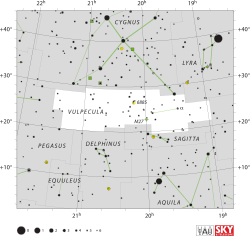9 Vulpeculae
| 9 Vulpeculae | |
 | |
| Observationsdata Epok: J2000.0 | |
|---|---|
| Stjärnbild | Räven |
| Rektascension | 19t 34m 34,89594s[1] |
| Deklination | +19° 46′ 24,24″[2] |
| Skenbar magnitud () | +5,00 (V)[3], +4,99 – 5,08 (V)[4] |
| Stjärntyp | |
| Spektraltyp | B8 III[5] |
| U–B | -0,43[3] |
| B–V | -0,093 ± 0,003[6] |
| Variabeltyp | Misstänkt variabel[4] |
| Astrometri | |
| Radialhastighet () | 5,00[7] km/s |
| Egenrörelse (µ) | RA: +13,091 ± 0,293[1] mas/år Dek.: +5,470 ± 0,248[1] mas/år |
| Parallax () | 5,8651 ± 0,1830[1] |
| Avstånd | 560 ± 20 lå (171 ± 5 pc) |
| Absolut magnitud () | -1,14[8] |
| Detaljer | |
| Radie | 4,08[9] R☉ |
| Luminositet | 431[8] L☉ |
| Temperatur | 10 917[10] K |
| Metallicitet | +0,00 (Fe/H)[11] dex |
| Vinkelhastighet | 185 ± 30[12] km/s |
| Andra beteckningar | |
| GCRV 11979, 2MASS J19343488+1946243, TYC 1609-2082-1, ADS 12622 A, GEN# +1.00184606J, NSV 12173, UBV 16609, AG+19 1890, GSC 01609-02082, PLX 4586.01, UBV M 23898, ALS 16587, HD 184606, PPM 136528, uvby98 100184606, BD+19 4063, HIC 96275, ROT 2815, WDS J19346+1946A, CCDM J19345+1947A, HIP 96275, SAO 104990, WEB 16877, CEL 4785, HR 7437, SKY# 36502, YZ 19 7529, CSI+19 4063 1, IDS 19302+1933 A, SSTGLMC G055.3515-00.1417, GS83 12, GC 27047, JP11 3117, TD1 24977, Gaia DR2 1825528467088509952[2][13] | |
9 Vulpeculae, som är stjärnans Flamsteed-beteckning, är en dubbelstjärna belägen i den södra delen av stjärnbilden, Räven. Den har en högsta skenbar magnitud på ca 5,00[3] och är svagt synlig för blotta ögat där ljusföroreningar ej förekommer. Baserat på parallax enligt Gaia Data Release 2 på ca 5,9[1] mas, beräknas den befinna sig på ett avstånd på ca 560 ljusår (ca 171 parsek) från solen. Den rör sig bort från solen med en heliocentrisk radialhastighet av ca 5 km/s.[3]
Egenskaper[redigera | redigera wikitext]
Primärstjärnan 9 Vulpeculae A är en vit till blå jättestjärna av spektralklass B8 IIIn,[5] där 'n'-notationen anger "diffusa" spektrallinjer på grund av snabb rotation med en projicerad rotationshastighet på 185 km/s.[12] Den har en radie som är ca 4[9] solradier och utsänder ca 431[8] gånger mera energi än solen från dess fotosfär vid en effektiv temperatur på ca 10 900 K.[10]
9 Vulpeculae är en misstänkt variabel som varierar mellan visuell magnitud +4,99 och 5,08 med en periodicitet som inte är fastställd.[4][14]
9 Vulpeculae har två rapporterade avlägsna följeslagare, 9 Vulpeculae B, med en separation på 9,3 bågsekunder och magnitud 13,4, och 9 Vulpeculae C, med en separation på 108 bågsekunder och en magnitud av 12,5.[15][5]
Se även[redigera | redigera wikitext]
Referenser[redigera | redigera wikitext]
- Den här artikeln är helt eller delvis baserad på material från engelskspråkiga Wikipedia, 9 Vulpeculae, 3 september 2020.
Noter[redigera | redigera wikitext]
- ^ [a b c d e] Brown, A. G. A.; et al. (Gaia collaboration) (August 2018). "Gaia Data Release 2: Summary of the contents and survey properties". Astronomy & Astrophysics. 616. A1. arXiv:1804.09365. Bibcode:2018A&A...616A...1G. doi:10.1051/0004-6361/201833051. Gaia DR2 record for this source at VizieR.
- ^ [a b] ”Basic data: V* 9 Vul – Variable Star” (på engelska). Centre de Données astronomiques de Strasbourg. http://simbad.u-strasbg.fr/simbad/sim-basic?Ident=9+Vul&submit=SIMBAD+search. Läst 5 juli 2019.
- ^ [a b c d] Ducati, J. R. (2002). "VizieR Online Data Catalog: Catalogue of Stellar Photometry in Johnson's 11-color system". CDS/ADC Collection of Electronic Catalogues. 2237. Bibcode:2002yCat.2237....0D.
- ^ [a b c] ”NSV 12173” (på engelska). The International Variable Star Index. AAVSO – American Association of Variable Star Observers. http://www.aavso.org/vsx/index.php?view=detail.top&oid=50797. Läst 5 juli 2019.
- ^ [a b c] Mason, Brian D.; Wycoff, Gary L.; Hartkopf, William I.; Douglass, Geoffrey G.; Worley, Charles E. (2001). "The 2001 US Naval Observatory Double Star CD-ROM. I. The Washington Double Star Catalog". The Astronomical Journal. 122 (6): 3466. Bibcode:2001AJ....122.3466M. doi:10.1086/323920. Vizier catalog entry
- ^ van Leeuwen (2007). ”Hipparcos, the New Reduction” (på engelska). http://vizier.u-strasbg.fr/viz-bin/VizieR-5?-out.add=.&-source=I/311/hip2&HIP=96275. Läst 5 juli 2019.
- ^ Gontcharov, G. A. (2006). "Pulkovo Compilation of Radial Velocities for 35 495 Hipparcos stars in a common system". Astronomy Letters. 32 (11): 759. arXiv:1606.08053. Bibcode:2006AstL...32..759G. doi:10.1134/S1063773706110065.
- ^ [a b c] Anderson, E.; Francis, Ch. (2012). "XHIP: An extended hipparcos compilation". Astronomy Letters. 38 (5): 331. arXiv:1108.4971. Bibcode:2012AstL...38..331A. doi:10.1134/S1063773712050015. Vizier catalog entry
- ^ [a b] https://www.universeguide.com/star/96275/9vulpeculae. Hämtad 2020-09-03.
- ^ [a b] McDonald, I.; Zijlstra, A. A.; Boyer, M. L. (2012). "Fundamental parameters and infrared excesses of Hipparcos stars". Monthly Notices of the Royal Astronomical Society. 427: 343. arXiv:1208.2037. Bibcode:2012MNRAS.427..343M. doi:10.1111/j.1365-2966.2012.21873.x. Vizier catalog entry
- ^ ontcharov, G. A. (2012). "Dependence of kinematics on the age of stars in the solar neighborhood". Astronomy Letters. 38 (12): 771. arXiv:1606.08814. Bibcode:2012AstL...38..771G. doi:10.1134/S1063773712120031. Vizier catalog entry
- ^ [a b] Abt, Helmut A.; Levato, Hugo; Grosso, Monica (2002). "Rotational Velocities of B Stars". The Astrophysical Journal. 573: 359. Bibcode:2002ApJ...573..359A. doi:10.1086/340590.
- ^ "9 Vul". SIMBAD. Centre de données astronomiques de Strasbourg. Hämtad 2019-03-14.
- ^ Samus, N. N.; et al. (2017), "General Catalogue of Variable Stars", Astronomy Reports, 5.1, 61 (1): 80–88, Bibcode:2017ARep...61...80S
- ^ Dommanget, J.; Nys, O. (2002). "VizieR Online Data Catalog: CCDM (Catalog of Components of Double & Multiple stars) (Dommanget+ 2002)". VizieR On-line Data Catalog: I/274. Originally Published in: Observations et Travaux 54. 1274. Bibcode:2002yCat.1274....0D. Vizier catalog entry





